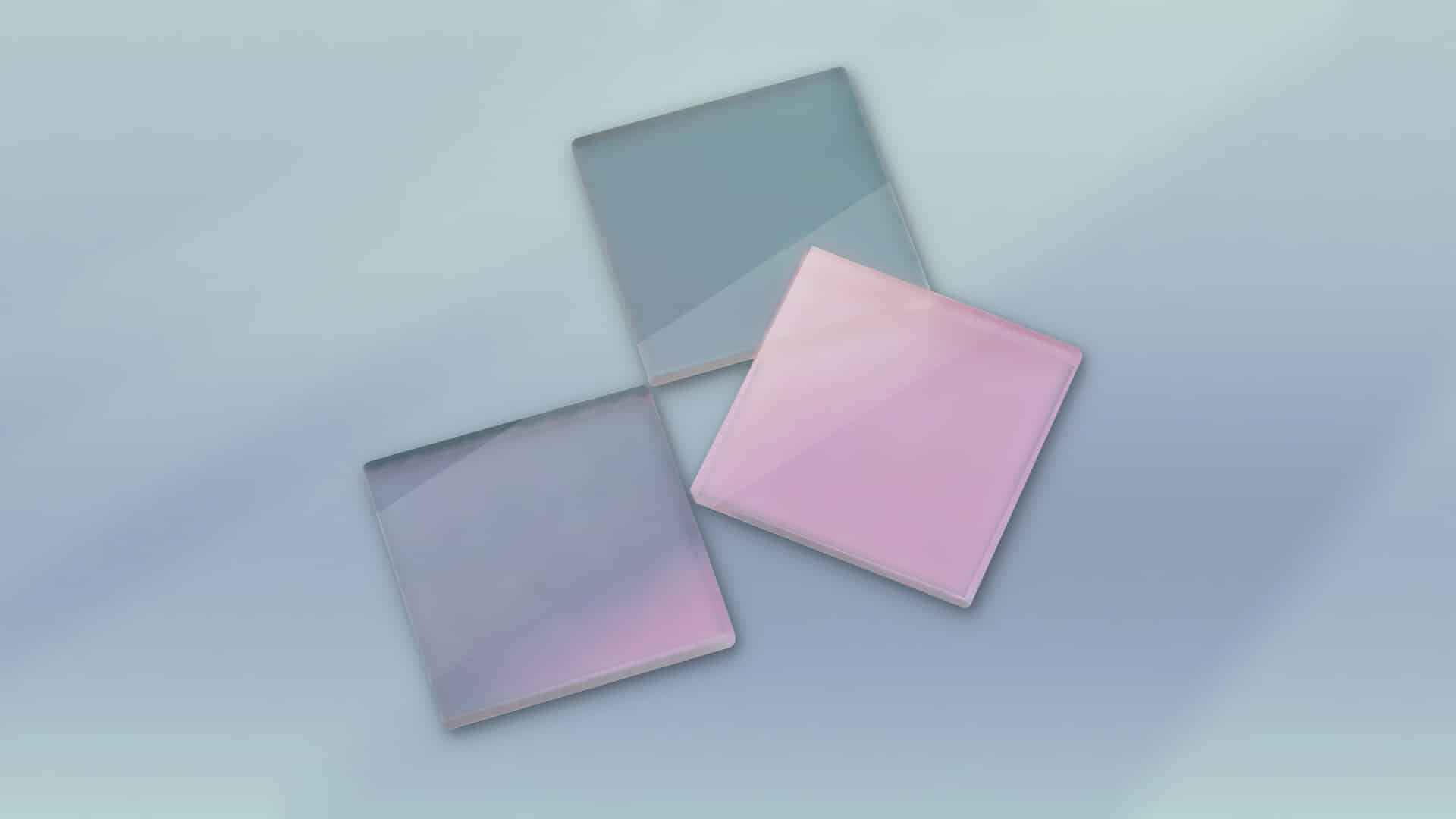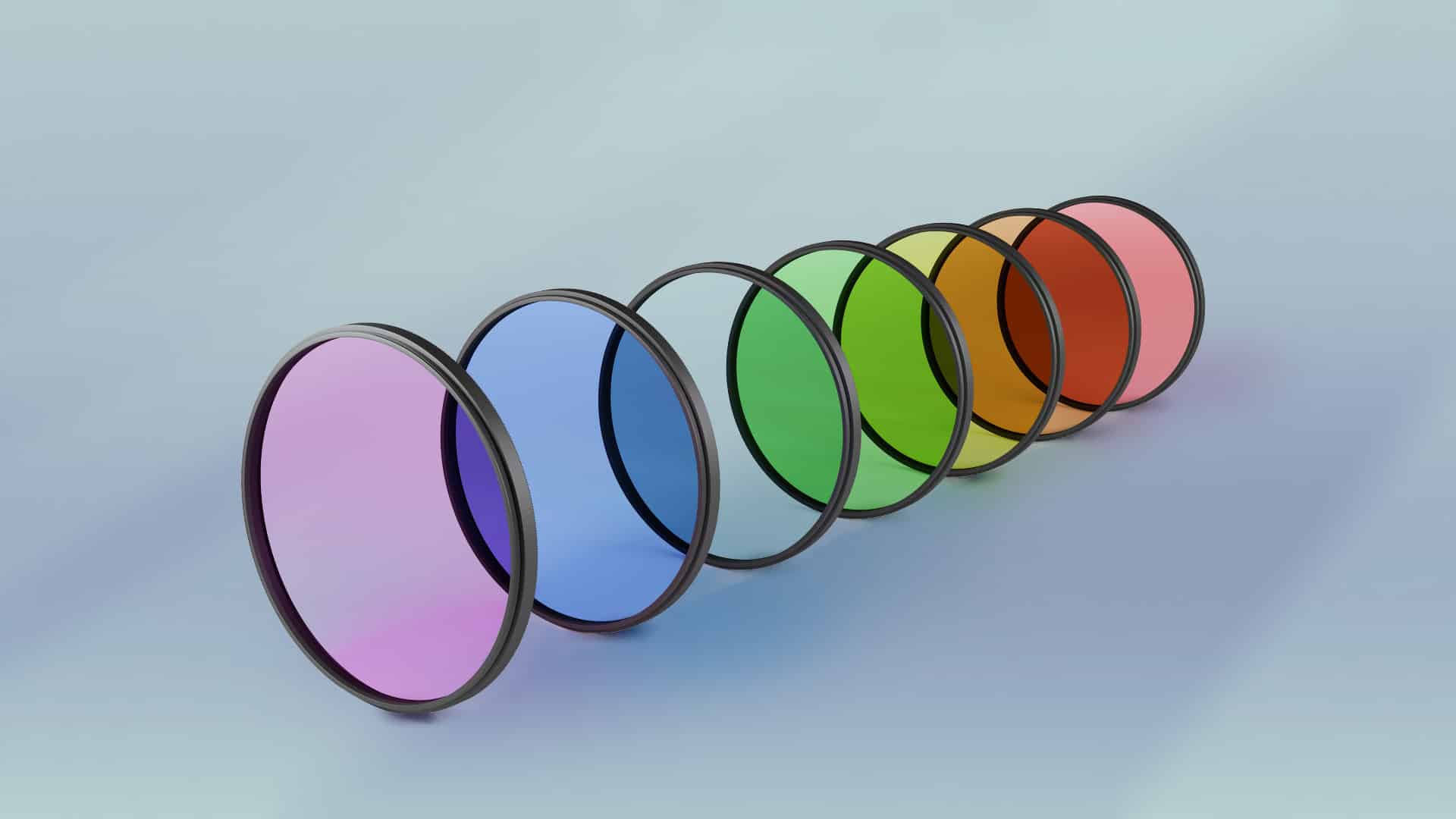What Optical Filters Do and How they Work
Optical filters and optical diffusers are pieces of treated or coated glass designed to modify the light reaching the sensor of a camera. They come in three types: as external filters that screw on over the front of a lens, as unmounted filters that slide into a holder in front of the lens, or as internal filters that fit between the rear element of the lens and the image sensor. Internal filters are sometimes called “in-camera window filters”.
Optical filters use a variety of coatings to either absorb, partially reflect, or polarize light. Here are 5 ways that optical filters can be used as a component of a camera system to solve problems.
5 Ways to Resolve Imaging Issues with Optical Filters
1. Control Light Levels with Neutral Density Filters
Most lenses and image sensors are designed to be as sensitive as possible in low light. This is fine if you’re using a camera system under controlled lighting conditions, but it can lead to problems outdoors or in very bright conditions. Larger lenses have variable apertures to control the amount of light reaching the sensor, but board mount lenses do not.
Neutral density filters are an elegant solution to this problem. Neutral density filters are simple partially darkened glass filters that block some of the light that passes through them. They come in different densities and can simply be screwed on over the lens to control exposure for optimal sensor gain and shutter speed.
Neutral density filters can be useful even with variable aperture lenses. In most machine vision and industrial applications, you want to use the smallest aperture possible under the lighting conditions in order to get the best possible depth of field. However, for creative applications and videography, you may wish to use a wide aperture to reduce the depth of field. Neutral density filters allow you to use a wide-aperture lens even in very bright conditions.
2. Get Rid of Glare and Improve Color and Contrast with Ultraviolet Cut-off Filters
If you are using a camera for visible light imaging outdoors under ambient light, unwanted wavelengths can reduce the overall image clarity and contrast. RGB color image sensors can suffer from a loss of image clarity and vibrance because of unwanted ultraviolet or infrared light.
An ultraviolet cut-off filter can help resolve these issues and improve the quality of the captured image.
For RGB sensors, a UV cut-off filter can block short wavelengths shorter than 400 nanometers (0.4 micrometers) that compete with visible wavelengths.
These filters appear to be nearly transparent to the naked eye. They only pass visible light, while absorbing or reflecting shorter wavelengths. These filters are pretty much universally recommended for outdoor photography or videography, and allow visible light sensors to capture an image with improved contrast and more natural, saturated colors.
The inverse of ultraviolet cut-off filters is ultraviolet band-pass filters. These are designed for use with specialized ultraviolet image sensors, and they only allow wavelengths in the range of 10 nanometers to 400 nanometers (0.01 – 0.4 micrometers) to pass through them.
3. Get Rid of Unwanted Visible Light When Using Infrared Sensors with Band Pass Filters
Short-wave infrared (SWIR) sensors use low-dispersion glass optics to minimize focal shift for wide spectral ranges. These sensors are incredibly useful for visualizing things that don’t show up under ordinary visible light. SWIR cameras typically require illumination from an infrared light source.
These sensors can be overwhelmed by visible light under bright conditions. Longer wavelengths in visible light can “saturate” the image sensor and reduce the overall image quality and sensitivity to the short-wave infrared light you wish to record.
Band pass filters can help fix this. There are a variety of band pass filters that block different ranges of visible light, while allowing infrared light to pass through, depending on the wavelength the sensor is optimized for, and the operating environment where the camera is used. These are sometimes “absorptive filters” – which means they absorb some wavelengths of light, while allowing other wavelengths to pass through.
Band-pass filters can also be created using dichroic or partially reflective coatings, which allow some light wavelengths to pass through, while reflecting others.
Filters for short-wave infrared light (SWIR) are broadband filters that will allow light in the 1000 to 2500 nanometer range (1-2.5 micrometers) to pass through them.
A table of common cutoff and band pass filters is shown below:
| Filter Type | Wavelength Behavior |
|---|---|
| UV cut-off (blocks UV light for VIS applications) | Blocks wavelengths shorter than 0.4 µm (UV cut-off) |
| UV band pass (allows UV light to pass through) | Passes 0.01 to 0.4 µm (UV band pass) |
| VIS band pass (allows VIS light to pass through) | Passes 0.4 – 0.78 µm (IR cut-off) |
| NIR (narrow bandpass for NIR applications) | Passes 0.78 – 1 µm (NIR band-pass) |
| SWIR (broadband filter for SWIR applications) | Passes 1-2.5 µm (SWIR broadband) |
4. Control Infrared Frequencies for Day/Night Cameras with Dichroic Filters
In some cases, you may need to control the amount of a particular wavelength of light that passes through a lens, without absorbing other frequencies. This is particularly true of day/night security cameras, which have to record visible light during the day, and infrared light at night, and use image sensors that are sensitive to both visible and infrared light.

Security cameras use sensors that require optics with broadband color correction and anti-reflection coatings.
These cameras can be switched between visible light (VIS) and near-infrared light (NIR) operation by using in-camera window filters, that can be moved in and out of the optical path.
At night, the camera can switch in an absorptive or reflective band pass filter that blocks unwanted visible light, while allowing infrared light to reach the image sensor.
During the day, infrared light can overwhelm the image sensor and distort the colors it records. You could use a dichroic filter to block those frequencies, allowing the sensor to produce colors accurately.
Dichroic filters have a thin film coating on them that reflects a particular range of wavelengths of light while allowing all other wavelengths to pass.
Dichroic filters can control the frequency of light with tremendous precision by being used in combination. In the days of film cameras, negative enlargers used a combination of cyan, magenta, and yellow dichroic filters to adjust the color of the light passing through the negative when making color prints.
5. Reduce Unwanted Reflections with Polarizing Filters
A common problem when recording images is dealing with reflections on glass, water, or other shiny surfaces. Unwanted reflections can reduce image clarity, and even completely block the visibility of underwater objects.
This problem can be easily addressed with polarizing filters. Polarizers are usually external filters that are screwed on over the front of the lens. Polarizing filters primarily come in two varieties: linear polarizers and circular polarizers – which are special cases of elliptical polarization.
Both linear and circular polarizers have the same purpose – which is removing reflections – but they work slightly differently:
- Linear polarizers will only allow light waves to pass through that are oriented in a single plane
- Many reflective surfaces polarize the light that bounces off them to varying degrees – depending on the angle of incidence. A polarizing filter at 90 degrees to the plane of polarization has the effect of removing these reflections
- Circular polarizers have two elements
- a linear polarizer and
- a “quarter wave plate” that rotates or “spins” the plane of polarization as the light passes through it.
- a “quarter wave plate” that rotates or “spins” the plane of polarization as the light passes through it .
- Circular polarizers are necessary for auto-focus and metering applications with cameras and optical instruments that include a fully or partially silvered mirror in the optical path. This includes DSLRs and some video cameras
- If you used a linear polarizer with these cameras, the mirror inside would be cross-polarized – causing the image to go dark
- Using a circular polarizer solves this problem and prevents issues with internal mirrors
There are a couple of drawbacks to using polarizing filters. The first is that they reduce the amount of available light reaching the image sensor by a full f-stop or more. The second is that they aren’t effective for removing reflections from chrome and shiny metal surfaces, because reflections from metal are not completely polarized.
Polarizers are fascinating filters. They reveal the pleasant aesthetic effect of deepening the blue in the sky, since more scattering and polarization occurs at blue wavelengths than at longer ones. They can also visualize some remarkable quantum effects. For example, if you stack two polarizers at 90 degrees to each other, it will have the effect of blocking light completely. However, if you add a third polarizer to the stack at an angle of 45 degrees, some light will pass through where the three filters align. This is quite a startling phenomenon, and many YouTube videos have been published demonstrating it.
Finding the Right Optical Filter for Your Needs
FRAMOS distributes a wide range of optical filters for machine vision applications and embedded vision systems. If you are looking for an optical filter to address a specific problem relating to your operating environment or vision system requirements, our optics experts can help you find the best match for your requirements.











